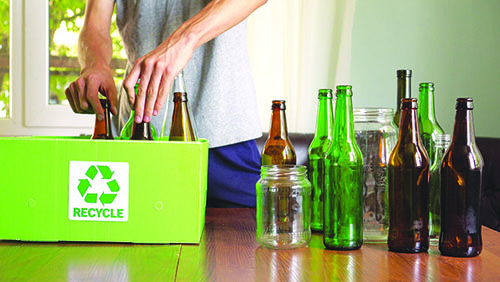From new regulations to deconstruction trends to fluctuating valuation of materials, the construction and demolition (C&D) recycling market is facing a myriad of new issues, trends, regulations, and challenges in recent years.
One of the biggest issues facing the C&D recycling industry is the burgeoning movement to implement the zero waste hierarchy of “highest and best use” of materials. Stacy Savage, founder and chief executive officer at Zero Waste Strategies said as a result of this initiative, the deconstruction of buildings is starting to see a stronger prioritization over demolition.
“Deconstruction involves carefully dismantling buildings to salvage materials for reuse, rather than simply destroying them,” Savage explained. This approach not only reduces the volume of waste sent to landfills but also allows for the recovery of valuable materials. As an example, the number of generational family farms has greatly diminished over time and for the past decade or so, reclamation architects have been recovering rare barn wood from the early 1900s for reuse as wood flooring in newly constructed homes.
“There have also been major advancements in innovative sorting and processing technologies that have also improved the efficiency of recycling operations, making it easier to separate and repurpose different types of materials,” Savage said.
Sarah Rege, sustainability director at Webcor, pointed out that in recent years, conversation about how C&D waste can contribute to the circular economy has evolved to focus on evaluating and handling.
“This requires more transparency of information, including the end markets for each diverted stream and, where possible, project-specific diversion rates,” Rege said. “More owners and clients are establishing zero-waste goals with a minimum 90 percent diversion for their waste, which is also desired for C&D waste.”
CleanHub chief executive officer Joel Tasche said that due to his role at CleanHub, he’s seen significant advancements in recent years within the C&D recycling market, mainly driven by technological innovations, regulatory changes, and a growing drive towards sustainability.
Advanced sorting technologies, such as automated and AI-driven sorting systems, are increasing the efficiency and accuracy of separating recyclable materials from waste, while reducing contamination and making recycled products of better quality.
“We’ve been using AI systems within our own operations – to help local waste-management services streamline collecting and properly disposing of recyclable and non-recyclable plastics,” Tasche said.
The C&D recycling industry is gradually shifting toward a circular economy. Unlike a linear system, a circular economy can utilize materials from demolished structures, which can be reused in new construction projects and rely less on new materials.
“Co-processing is something that utilizes materials that can’t be recycled – this is when non-recyclable items are safely incinerated, turning it into fuel for the production of cement,” Tasche said. “It’s certainly not a green method, but it’s the best option we have for dealing with non-recyclable materials at the moment. Working this way also drives collaboration between construction companies, recyclers, and governments so that the recycling of materials is more efficient and cost effective.”
Embracing Challenges
As the C&D industry continues to evolve, so too do the challenges that the industry faces. According to Savage, one of the biggest challenges in the C&D recycling industry is the variability in material composition. Unlike traditional recycling streams, C&D debris can be highly diverse, making it difficult to efficiently sort and process materials.
“Another challenge is the fluctuating market demand for recycled materials, which can impact the profitability of recycling operations,” Savage said. “Regulatory barriers and inconsistent policies across different regions of the country also create bottlenecks for the industry, making it difficult to establish standardized practices and pricing and the widespread adoption of deconstruction methods.”
Additionally, most cities across the U.S. do not have a climate action plan in place that can provide resiliency guidance on capturing recoverable C&D materials after major natural disasters, especially flooding events. According to Savage, typically, millions of pounds of potentially salvageable materials are gutted from affected homes and other structures and sit at the curbside, rotting for weeks, awaiting trash collection.
Rege added that maintaining high diversion rates and end markets for all the diverted material is top of mind for C&D recyclers.
“Categories of waste that have not been traditionally diverted, such as interior materials like carpet and ceiling tiles, require broader networks to effectively divert material aside from manufacturer take-back programs,” Rege said.
As with any industry, the market demand for recycled materials fluctuates due to prices and changing economies. As Tasche pointed out, coupled with the need to comply with local, state and federal regulations, it can be daunting and costly for recycling operations.
“This makes investment into recycling infrastructure complicated, as high initial costs for establishing advanced recycling facilities and technologies can be a barrier, particularly for smaller firms,” Tasche said. “We’ve seen this firsthand.”
Trends To Note
One of the latest trends in the C&D recycling industry is the increased adoption of circular economy principles. This involves designing structures with their eventual deconstruction and material recovery in mind.
“Ideally, there is a catchment system established through ‘eco-depot’ facilities where salvaged materials from deconstruction projects are brought in. Materials are analyzed through AI scanning technology for quality and consistency and given a contamination score, and then they are made available for purchase to contractors and the general public,” Savage explained.
Another trend is the rise of urban mining, where materials from old buildings and infrastructure in urban areas are recovered and reused in new construction projects.
Furthermore, Savage pointed to the push towards greater collaboration between stakeholders, including architects, contractors, and recyclers, to ensure that recycling considerations are integrated throughout the entire lifecycle of a building.
Tasche added that the most important trend facing the C&D recycling industry is the implementation and use of AI.
“More accurate data can be gained and used to make processes more streamlined and efficient. We’ve found this with our own operations,” Tasche said. “Our software has been developed by our in-house team and tracks waste from collection to final recovery, where the material goes through a laboratory.”
CleanHub also developed an app that makes the data-logging process more seamless for their collection teams on the ground. Not only does this help maintain transparency, but it makes the process much easier for workers.
“The collection crew scans a QR code on the door, which opens our app and registers that they have now checked in to a specific location to collect waste,” Tasche said. “App users can then track the status and movement of the pickup on a dashboard, which shows when the plastics have been sorted.”
New Regulations
There are several new regulations and policies that are starting to impact the C&D recycling industry. For example, many regions are implementing strict waste diversion mandates, requiring a higher percentage of C&D materials to be diverted from landfills and recycled. For example, upon council approval, the City of Austin, Texas, C&D Recycling Ordinance intends to increase the diversion requirement of C&D projects from 50 percent to 75 percent, and eventually to 95 percent.
“There are new regulations focused on reducing carbon emissions and promoting sustainable building practices, which can indirectly influence the demand for recycled materials and deconstruction services, which also supports the Zero Waste Hierarchy,” Savage said.
The 2024 U.S. Senate Environment and Public Works Committee also has been conducting information gathering sessions on extended producer responsibility for many types of materials. These discussions include the possible assessment of “eco-modulation fees” to incentivize the decrease of product toxins and problematic materials in the recycling stream and increase standardization across some materials.
“Although plastics and packaging are the main foci this session, there is nothing halting these types of discussions shifting to the C&D industry in the future,” Savage said.
“Passing the responsibility onto the producer is the best way to drive change away from current polluting practices,” Tasche added. “Incentivizing businesses to make products more recyclable is the type of policy needed for a circular economy.”
In addition, Rege pointed out that in California, beginning in 2022, SB 1381 requires organic waste collection including collection from jobsite offices.
“Historically, California has led in environmental legislation that is then implemented across the country,” Rege said. “Providing infrastructure to support organic waste collection will be impactful in areas where it does not currently exist.”
Continuous Evolution
From an environmental perspective, the C&D recycling industry continues to evolve to meet increased concerns on the environmental impact of C&D debris.
Savage says one key area of focus will be increasing the recovery rates of high-value materials, such as metals, concrete, and timber, through improved sorting and processing technologies, such as drones for aerial inspections after natural disasters, AI scanning devices to detect mold development, and infrared thermography and ultrasonic testing equipment to determine structural soundness.
“There will also be a greater emphasis on deconstruction and material reuse, as these methods offer significant environmental benefits compared to traditional demolition,” Savage says. “The industry will likely see more integration of life cycle assessment (LCA) methodologies to evaluate the environmental impact of different recycling and disposal options, helping to identify the most sustainable practices.”
There will be ongoing efforts to reduce the carbon footprint of recycling operations using renewable energy and low-emission transportation options.
For Tasche, understanding the lifecycle of various products and materials develops more of an understanding as to how they may pollute after initial use. This has happened with plastic in recent years – straws and plastic bags – shifting the industry towards more sustainable solutions.
“With more governmental changes and regulations being implemented around manufacturing and recycling, this will have an impact on C&D too – especially as it’s noted as being one of the most polluting industries,” Tasche said. “As we’re able to track waste more accurately than before, being transparent with reporting around sustainability will be vital for future business. As more incentives are provided, companies will be naturally encouraged to have less environmental impact.”







